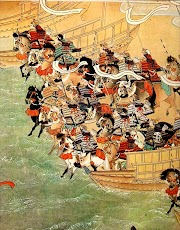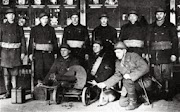When examining the impact that the Italian 10th MAS had during its years of service for Benito Mussolini’s (b.1883-1945) government from 1940-1943, one must understand the diverse composition of the brigade itself. Essentially four different branches comprised the unit during its fight against the British Royal Navy and Allied shipping, the Gamma frogmen, manned torpedo craft, midget submarines, and assault motorboat craft.
Early Development of the Italian Assault Flotillas, 1917-1940
Pioneering Italian frogmen and naval officers (Regia Marina) Raffaele Rossetti (1881-1951) made history in early November 1918 when he and another Italian diver snuck into Pula Harbor (modern day Croatia) guiding a crude early manned torpedo nicknamed the mignatta, the leech, into the bow of the Austro-Hungarian battleship the SMS Viribus Unitis, sinking the vessel as well as another merchant ship.
The Italians respected and pursued (slowly) alternative means to building a great battleship fleet because they knew the British and the French could outclass them many times over in main battleships and destroyers. Mussolini and the Italian Naval command from 1935-1941 realized that they could inflict losses on these larger navies using small maneuverable crafts. Though there were numerous types of craft built they were all known colloquially as barchino, the little boats.
These assault motorboats were designed to be one to two man assault craft, some were weapons motor torpedo boats whilst other were explosive laden weapons systems. A renewed interest in manned torpedoes and naval assault craft began in 1935. Italian naval officers Teseo Tesei and Elios Toschi spearheaded these early efforts to perfect the two man self-propelled torpedo. Their efforts from 1935-1936 weilded several prototypes but the basic slow speed torpedo (SLC) design used during World War 2 came to be known as the maiale, or the hog (pig).
Italian Navy Captain Teseo Tesei (b.1909-1941)
Weighing nearly 1.5 tons the maiale craft were heavy, ungainly and unreliable beasts which were very hard to steer and prone to mechanical mishaps. Theoretically the SLC manned torpedoes could to 2-3 knots at a depth of 50-75 feet. The warhead placed at the end of the manned torpedo detached allowing the two man crew to attach the 550+ pound explosive to the hull of an enemy ship. The Frogmen school attached to the 10th Assault MAS and to the Naval Infantry was arguably the most elite section in all of the Italian navy during the war.
Only about 50 Gamma group (frogmen) assault swimmers saw action from 1940-1943. The selection course for these swimming saboteurs was brutally challenging and we can assume that the men who passed selection were most certainly elite swimmers. They wore the advanced Belloni dive suits, designed by Lt. Angelo Belloni of the Xª MAS Flotilla, and were equipped with the Pirelli ARO rebreathers. Gamma frogmen had the use two tanks of pure oxygen for about 6 hours of underwater breathing, plus a dive knife, and most wore a wrist compass and dive watch as well.
Xª MAS diver wearing a Belloni dive suit with a rebreather
SLC Manned Torpedo c.1942
The largest and most costly early operative failures came on 26-27 July attack against Valletta the capital of Malta by two SLC manned torpedoes and nine MAS assault motorboats. The task force quickly penetrated the harbor but were spotted and exposed to savage artillery and small arms crossfire. British Hawker Hurricanes bombed them from the air and the raid turned into a calamitous death trap for those who had been spotted on the surface of the harbor waters. Capt. Tesei sacrificed himself by blowing up his manned torpedo and destroying the St. Elmo’s Bridge in a last act of suicidal bravery. The Italians lost all their craft save for one of the barchino, fifteen were killed including the Decima Flottiglia’s commanding officer, the founder of the Italian manned torpedo program Capt. Tesei, and eighteen more were taken prisoner.
Italian SLC Manned Torpedo
Battle Record, 1941-1943
In March 1941, La Decima assault motorboats carried out a minor successful raid against the British at Souda Bay off the coast of Crete. In this action the HMS York was severely damaged and another merchant ship was sunk. The next success of the brigade came in September of ‘41 when three manned torpedoes made a successful attack on three merchant ships near Gibraltar, sinking one of the vessels. The crowning achievement of the Italian's SLC manned torpedo program came on 18-19 December 1941 when three SLC cruised into Alexandria Harbor after being dropped by the submarine Sciré commanded by Junio Valerio Borghese (b.1906-1974).
Three crews of six Gamma frogmen found targets, the HMS Queen Elizabeth, the HMS Valiant, and the merchant tanker Sagona, damaging all severely with explosive charges. Both British battleships were severely damaged and another destroyer was also damaged at a loss of eight British sailors though all six frogmen were captured in the action. Lt. Luigi Durand de la Penne (b.1914-1992) was the frogman who wrecked the Queen Elizabeth although he was captured after attaching a magnetic mine to the bottom of the ship. This action left the British with only a skeleton force of light cruisers and destroyers in the Mediterranean.
Italian SLC c.1942
Lt. de la Penne served as an assault swimmer for the Allies after his capture and was awarded the Gold Medal of Military Valour in a 1944 ceremony attended by Admiral Sir Andrew Cunningham, the commanding officer whose ship he had crippled three years earlier. In the modern Italian Navy (Marina Militare) Durand de la Penne has a class of destroyers named after him and is still celebrated as a hero of the modern Italian navy.
From June 1942 to August 1943, the 10th Assault Flotilla was involved in numerous sinkings and the severe damaging of Allied ships from Sevastopol in the Crimea to Algiers in North Africa. During this period the 10th Flotilla sank or damaged ships from the United States, Britain, Greece, the Soviet Union, and from Norway amongst many other nations. Italian assault motorboats and midget submarines operated in the Black Sea with little notable results during 1942-43 as well in an attempt to aid their German allies on the Eastern Front.
Sub Lt. Luigi Durand de la Penne, Gamma saboteur c.1941
The Gamma frogmen enjoyed a string successes disproportionate to their size and length of service record. Their first operation was launched in July of 1942 when twelve swimming saboteurs damaged three merchant ships moored near Gibraltar. During the later launched Operation Stella just one Gamma diver sank three British cargo ships in neutral Turkish waters between June-July 1943. Italian frogmen sunk or damaged numerous cargo ships off the coast of North Africa and in the Mediterranean until August 1943, when the last Gamma attack was launched on Gibraltar, sinking three merchant vessels.
Conclusion
By the summer and fall of 1943 the war in North Africa and the Mediterranean theatre had taken a very bad turn for Mussolini and his fascists militarily, diplomatically, and politically. The 10th MAS enjoyed several minor scattered successes in the summer of 1943 before the September Armistice of Cassibile which ended the war between Italy, now led by Marshal Pietro Badoglio following a coup (b.1871-1956) and the Allies. The 10th MAS unit was reformed as an anti-partisan and naval commando battalion following the creation of the Italian Social Republic (the RSI or Republic of Salo), the Nazi puppet state in northern Italy. Now led by Commander Junio Valerio Borghese, the Decima became a near independent axis allied battalion, combating Italian partisans and Yugoslav guerillas in the north and later the Allies on land and sea before the end of the war in April 1945.
Decima Flottiglia MAS, La Decima or Xª MAS
Suggested Further Reading
Italian Navy & Air force Elite Units & Special Forces 1940-45. By: P. Crociani & P.P. Battistelli, Illustrated by M. Stacey (Osprey Publishing, 2013)
The Black Prince and the Sea Devils: The Story of Valerio Borghese and the Elite Units of the Decima Mas. (Da Capo Press, Cambridge, Massachusetts, 2004)
The Royal Navy and the Mediterranean Volume II, November 1940-December 1941. Edited by David Brown, (2002).
Frogmen First Battles. By: William Schofield and P. J. Carisella
(Branden Publishing Company, Boston, 1987).
Sea Devils-Suicide Squad By J. Valerio Borghese, Translated James Cleugh.








.bmp)




